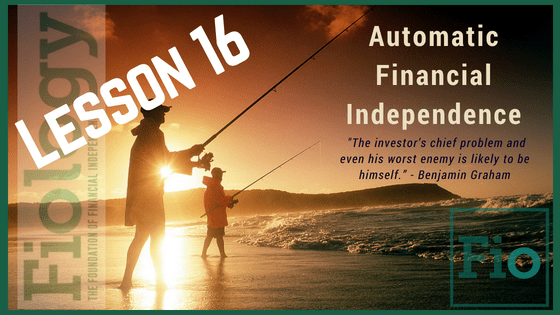Automate the Boring Stuff for Financial Independence
June 6, 2018 December 21, 2021 /
Why is it better to automate the boring stuff?
Once we automate finances, in particular the boring financial stuff on our way to Financial Independence, we can focus on other important aspects of our lives with the assurance that we are doing the things necessary to reach our goals.
Putting our routine financial processes on autopilot reduces the number of actions we have to take on a regular basis. It also distances ourselves from interacting with a significant portion of our money. That isn’t to say you’ll not care about where your money is going. You’ll monitor monthly just to check and make sure your process is performing as designed.
Automate the boring stuff and gain more time to do more fun stuff!
When you decided to become Financially Independent, you took a hard look at not only your monthly bills but your contributions to your retirement accounts. You plan for and decide just how much you are going to contribute. Once that plan is solid, you simply automate your finances and think far less about the tedious aspect of opening envelopes and writing checks. Wouldn’t you rather spend that time doing something you value more?
Practically, when we automate the boring stuff, we reduce the likelihood of an error. An example of human error might be a missed payment because an envelope got placed in the bottom of a desk drawer, never to be seen again.
Any recurring monthly bills and investment contributions can be automated. Just make sure you continue to review your credit card statements and checking account transactions to ensure you meet any surprises head on. Many banks will allow you to set up automatic payments with Bill Pay through online banking if you desire to pay bills using your checking account.
Many in the Financial Independence community put recurring bills (not investment contributions) on credit cards and then pay the entire balance off (via autopay) monthly in order to take advantage of credit card rewards programs.
So what is this “boring stuff” you are supposed to set on autopay?
Here is a general checklist of routine financial processes you may consider automating.
- IRA contributions (double check at the end of the year to ensure you are set up to max out the next year as contribution limits change every few years)
- Taxable brokerage account investments (some mutual fund brokerages allow you to automate your fund purchases. for example, I have my monthly contributions purchasing shares of VTSAX without me having to do it manually every month)
- Emergency fund contributions
- College fund contributions
- UTMA/UGMA accounts
- Contributions for any planned future purchase (car, Christmas, vacation, etc.)
- Rent or Mortgage
- Car Payments
- Insurance (homeowners, auto, umbrella, renter’s, health, etc.)
- Cell Phone bills
- Utilities (water, electricity, cable internet, gas, sewage, trash, stormdrain, etc.)
- Credit Cards (from checking, pay in full every month if possible, don’t forget to review statements)
- Streaming Services (take a good look and make sure you still value them)
- Subscriptions (magazine, beauty boxes, wine clubs, newspapers, gaming, etc. – take a good look and make sure you still value them.)
An additional benefit when you automate the boring stuff.
Up to this point, maybe you haven’t paid close attention to your statements or e-receipts. As you go through the process of determining what you’ll place on autopay, you’ll likely discover at least a few active subscriptions that no longer bring you value. These might include magazine subscriptions, online membership subscriptions, software subscriptions, Amazon subscriptions, streaming television subscriptions, etc.
Use this as an opportunity to practice decision-making in alignment with your values. Perhaps you decide to cancel a monthly subscription because you decide an extra fifty bucks a month can go to your child’s college fund.
Every little bit helps.
Read:
- Your Automatic Investment Plan by David Weliver of www.moneyunder30.com
- Automation and Organization: A Recipe for Success by Cody of flytofi.com. This blog post describes how we can use automating in many aspects of our life, including finances.
- Should You Automate Your Finances? by Liz of lessdebtmorewine.com
- Should I Pay Bills with a Credit Card or Checking Account? by Zina Kumok of experian.com
Watch:
- MMS009: Tips for Automating Your Finances by Kyle Prevost of moneymastermindshow.com
Listen:
- Episode 017: Automating Your Finances by Chris Browning of popcornfinance.com
Take Action:
- Based on the resources provided in this lesson, determine what steps you can take today to set up automated payments and/or transfers to reduce the number of routine financial decisions/actions you make. Then, over time, become more assertive and invest a higher percentage of your income.
Additional Resources:
- David Bach’s 7 Places Your Money Needs To Go Automatically by David Bach of davidbach.com on YouTube
Quote:
“The investor’s chief problem and even his worst enemy is likely to be himself.” – Benjamin Graham

Awesome content and thanks for including my post!
Cody,
Absolutely! I’m looking forward to seeing you at CampFI South in September 2018.